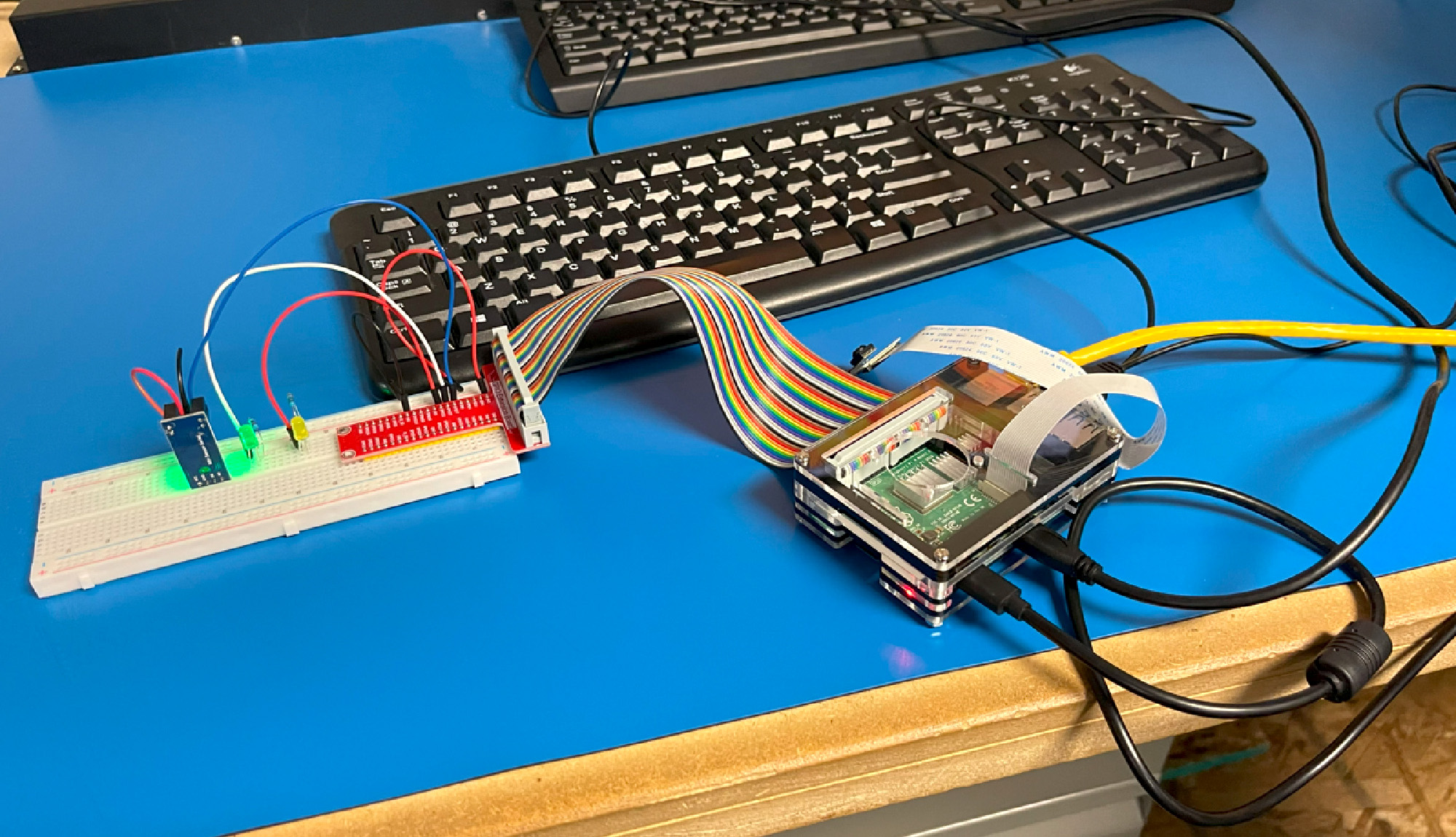A group of high school students at STEM School Highlands Ranch in Denver has invented a dashcam-style device that uses artificial intelligence to detect wildlife on roads and warn approaching drivers. The device uses an infrared camera to scan for animals in the road and a special AI model to identify them. It’s now in its final prototype phase, and the team of young engineers hopes the invention can be used by drivers everywhere to cut down on the amount of wildlife-vehicle collisions that occur every year.
The project began in September, when Siddhi Singh (then a sophomore) told computer science department head Tylor Chacon she wanted to enter the 2024 Samsung Solve for Tomorrow contest, a nationwide challenge that encourages high-school engineering clubs to come up with innovative solutions to real-world problems. The top ideas are rewarded with cash prizes, awards, and industry support.
Singh and her teammates Dhriti Sinha, RJ Ballheim, and Bri Scollville decided wildlife collisions are a problem worth addressing. Around 5,000 collisions with wildlife occur every year on roads in their state, costing some $80 million annually, the Colorado Department of Transportation reports. Looking at the country as a whole, the annual number of wildlife-collisions climbs to more than one million, with roughly 200 human fatalities in a typical year, according to a 2008 study. It’s why deer are the deadliest animal in America.
“We all felt a connection to that problem, since we live in Colorado,” Singh tells Outdoor Life. “We have lots of beautiful wildlife but on the flipside, we also have a lot of collisions. So it was a really important problem for us.”
Photo by Utah DWR
At first, the group wanted to create a noise apparatus that would scare deer and other wildlife away. But after discussions with various experts, including CDOT and Colorado Parks and Wildlife, it became clear that deterrence wouldn’t be an effective way to avoid wildlife collisions. (Ever honk at a deer only for it to stand there and stare at you?)
CDOT pointed out that their current method of wildlife-vehicle collision avoidance involved installing lit signs on roadways, using agency funds at taxpayers’ expense. While these signs are useful in keeping drivers cautious in areas with high wildlife density, they can’t be everywhere at once. The group wanted to create a device that would give drivers more ownership and individual responsibility over avoiding collisions, something drivers could use everywhere they went.
Read Next: The Key to Solving Big-Game Migration Conflicts? Roadkill
“Before finalizing our design, we looked at current solutions,” Singh says. “It’s important when creating new technology to look at what’s already there, and see how you can make it better. CDOT was spending millions on these signs. They’re expensive, they’re stationary, and people sometimes just ignore them. So a personal device that directly alerts the driver would be a lot better than a stationary device that people would ignore.”
Every expert the group spoke with liked to remind them of the challenges and roadblocks to such an invention, Chacon says. For the device to function reliably in Colorado’s varied weather patterns, it couldn’t be triggered by rain, snow, sleet, or debris kicked up by wind. It also needed to work in the dark, which is when most wildlife-vehicle collisions occur. Infrared, or thermal imaging, which is used in many trail cameras and an increasing number of optics (it’s also cause for some debate among hunters), seemed like the best answer to all these challenges.

Photo courtesy STEM School Highlands Ranch
“Infrared is a wavelength emitted by many animals,” Scoville says. “It’s an efficient way to detect animals and other lifeforms, especially in lowlight and dark situations. If you’re driving at night, you’re not going to be able to see animals you might hit. We want the device to detect wildlife [well] before human vision would be able to detect it, because otherwise, the device isn’t doing much.”
The final design, which is still in the works, would use a Flir infrared camera to take a constant stream of images of the road ahead of the car. The camera would feed those images through a special chip programmed with the AI model Singh designed and taught to recognize deer shapes. The dash-mounted device would then signal the driver with a gentle LED flash and a noise when a deer shows up in the frame. The group intends for the device to detect deer and other wildlife from around 500 feet away, giving a driver traveling at 80 mph over 4 seconds of notice to avoid a collision. While that might not sound like much time, it would certainly give drivers a leg up over the traditional method of avoiding deer collisions: waiting to see them flash in front of your headlights, slamming on the brakes, and hitting them anyway. (Traditional headlights only stretch out to around 250 feet.)
The students’ latest prototype won the state level of the Samsung competition. Their prize package included some $12,000 in education tech, including laptops, a Smart Board, and a phone with a high-quality camera for their school to use. They distributed some of their prizes to other departments within the school and donated a cash gift card to a local elementary school to help fund a school garden. Although they failed to win at the national level of the competition, this doesn’t faze the group much.

Photo courtesy STEM School Highlands Ranch
“We didn’t exactly lose,” Sinha tells Outdoor Life. “You lose when you give up on the project. But we didn’t give up. We’re still working on it and refining our idea, so we haven’t lost.”
A lower-quality version of the device has already been tested on the school’s security dog while mounted on a remote control car. But the group has taken the device way beyond its initial design phase, Chacon says.
“We’re using higher-end technology and we’re in the final phase of prototyping,” he says. “We’re using a real chip that’s meant for AI models, and a $300 Flir camera. It’s a real device, it’s not just the cheap infrared sensors and cameras that people saw on our initial prototype. We have the horsepower to actually do this.”
Read Next: Feds Plan to Spend $350 Million on Wildlife Crossings. Secretary of Transportation Pete Buttigieg Tells Us Why
The group is currently preparing the final prototype and thinking about how to test it. They’re also looking for more infrared trail camera footage of deer to continue training the AI model on. The more infrared deer images the group can feed it, the more likely the model is to recognize a red blob with four legs and a head as a deer on the road. They hope to eventually train the model to recognize other wildlife species.
Chacon thinks the responsibility of testing the device on a real vehicle near real wildlife might fall on him, seeing as how none of the girls have their drivers’ licenses yet. But he doesn’t mind.
“Seeing them use some of the skills they’ve learned in engineering and computer science to build something no one has ever thought of before, it’s like the height of my work,” Chacon says. “This is the top prize. I feel like I won the championship belt of teaching.”
Read the full article here




